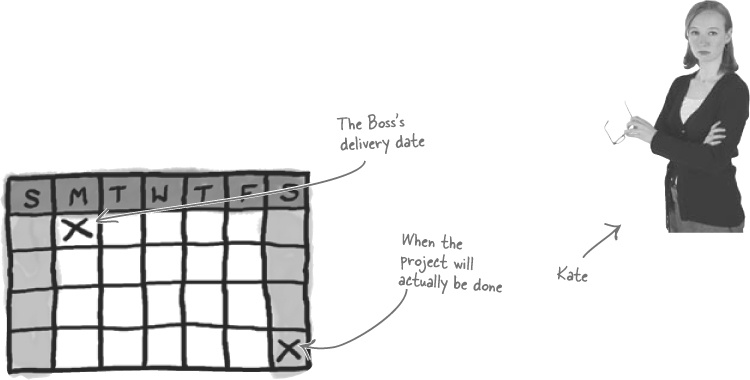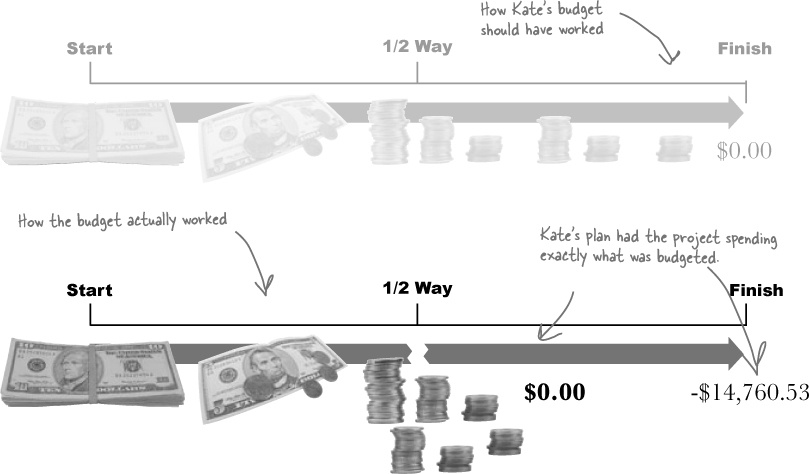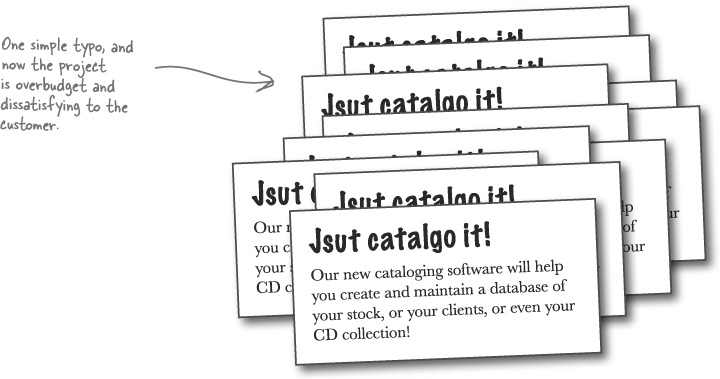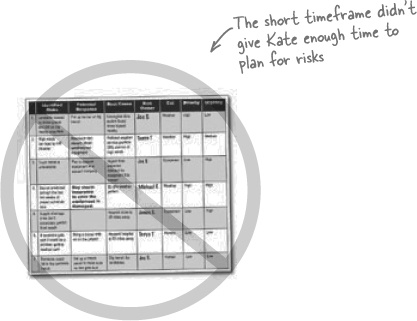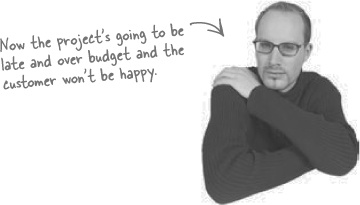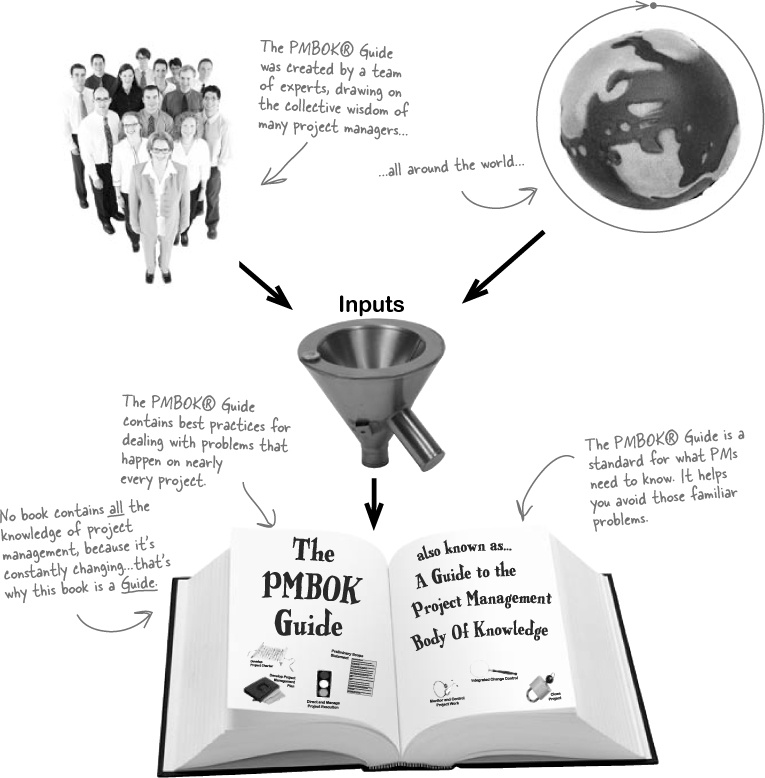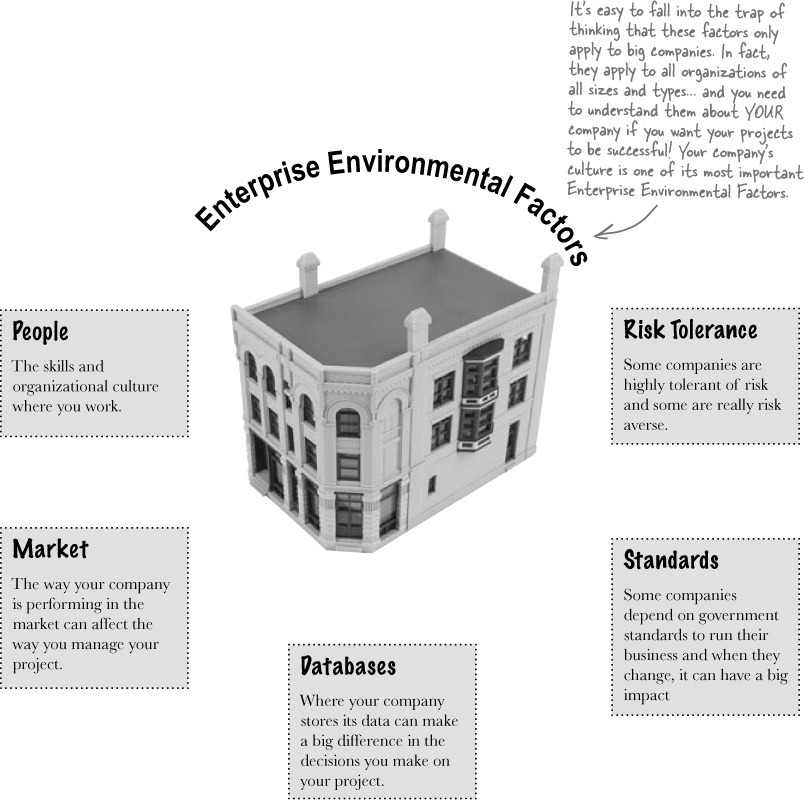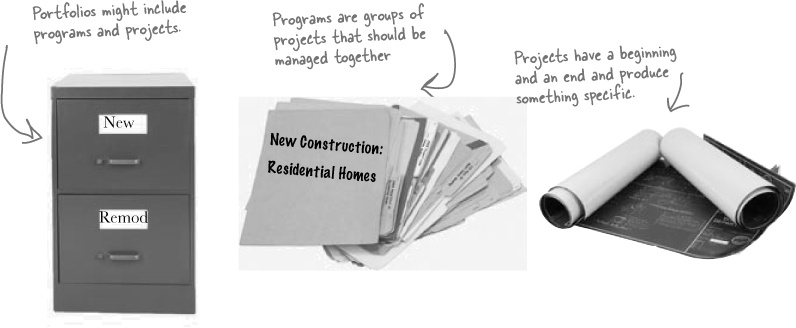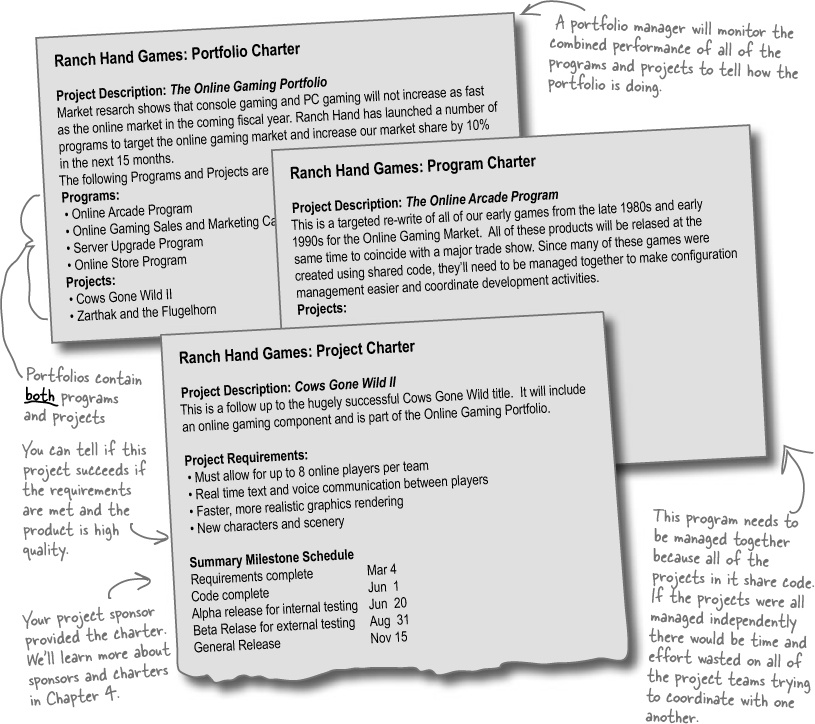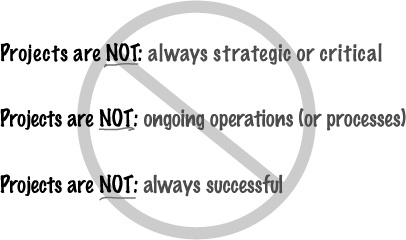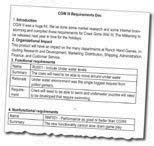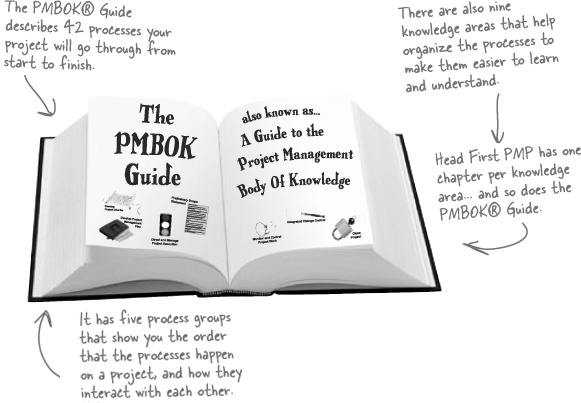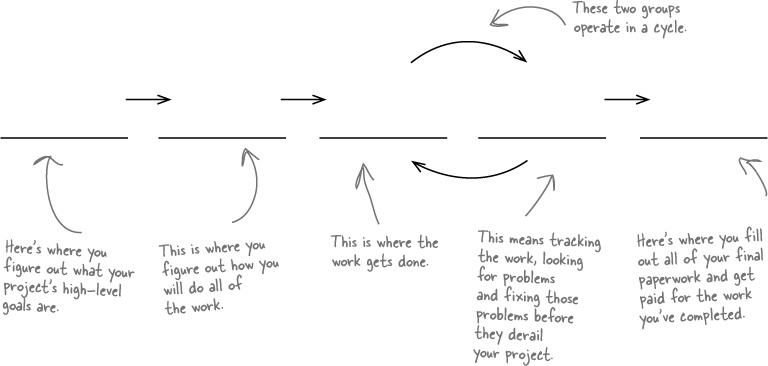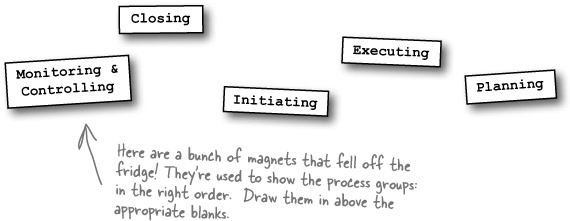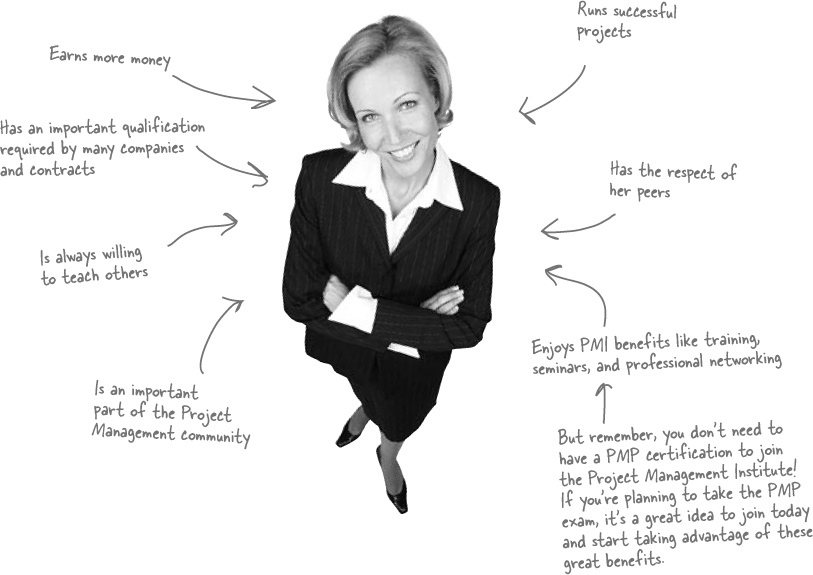Chapter 1. Introduction: Why get certified?
Tired of facing the same old problems? If you’ve worked on a lot of projects, you know that you face the same problems, over and over again. It’s time to learn some common solutions to those problems. There’s a whole lot that project managers have learned over the years, and passing the PMP® exam is your ticket to putting that wisdom into practice. Get ready to change the way you manage your projects forever.
Do these problems seem familiar?
Kate’s boss promised a delivery date that she couldn’t possibly meet.
Then, when the project was halfway done, the customer demanded a big change.
Then, just as the project was about to be completed, someone noticed a typo, and 10,000 leaflets had to be reprinted.
Then, when it was time to fix those typos, she realized that the printer was booked for another project.
And even though she knew there was a pretty good chance that someone else might need the printer, she didn’t have time up front to come up with a backup plan.
Projects don’t have to be this way
It may seem like all projects have these types of problems, but there are proven solutions to them... and someone else has already done a lot of the work for you! Realizing that all projects have common problems with solutions, The PMBOK® Guide was put together to pass those solutions on to you.
Your problems... already solved
Every project eventually runs into the same kinds of issues. But a project manager with good training can spot them and quickly figure out the best solutions. The PMBOK® Guide will help you:
✓ | Learn from past projects that have run into similar problems to avoid running into them again. |
✓ | Plan and execute your projects to avoid common pitfalls. |
What you need to be a good project manager
The PMBOK® Guide is full of practical tools that can help you to manage your projects better. But all of that doesn’t mean much if you don’t have the three core characteristics of a successful project manager. You’ve got to pay attention to all three if you want to make your project a success. This is what you’ll need if you’re going to take on the role of project manager:
Knowledge
If you pay attention to what’s going on in the field of project management, you can learn from everyone’s successes and mistakes so that you can be better at your job.
Performance
It’s not enough to know what you need to do—you’ve got to deliver, too. This one is all about keeping your nose to the grindstone and doing good work.
Personal Skills
Since you’re managing people, you’ve got to pay attention to what motivates them and what makes things harder on them. Your job as a PM is to make personal connections with your team and help keep everybody on the right track.
The PMBOK® Guide is just a guide, but if you understand all the material in it, then you’ll ultimately be a better project manager.
You can’t manage your project in a vacuum
Even the best project managers can’t control everything that affects their projects. The way your company is set up, the way people are managed, the processes your team needs to follow to do their jobs... they all can have a big impact on how you manage your project. On the exam, all of those things are called Enterpise Environmental Factors.
Understand your company’s big picture
Your project is an important part of the work your company is doing, but you need to understand how it fits in to the higher level strategy your company is executing, too. That’s where programs and portfolios come in.
Portfolio | Program | Project |
A portfolio is a group of projects or programs that are linked together by a business goal. If an architecture firm was venturing into remodelling existing buildings as well as designing new ones, they might split their firm’s efforts into separate New Construction and Remodelling portfolios since the goals for each are quite different. | A program is a group of projects that are closely linked, to the point where managing them together provides some benefit. The firm knows from experience that creating huge skyscrapers is dramatically different than building residential homes, so residential home construction would be its own separate program. | A project is any work that produces a specific result and is temporary. Projects always have a beginning and an end. Building a house is a classic example of a project. Projects can be part of programs or portfolios, but portfolios and programs can’t be part of a project. |
Portfolios, programs, and projects
Let’s take a look at a charter for a portfolio, a program, and a project for a software company called Ranch Hand Games to get a better understanding of how they break down.
A program is a group of projects that are managed together because of a shared benefit.
What a project IS...
A day in the life of a project manager
You know what a project manager does: gets a project from concept to completed product. Usually a project manager works with a team of people to get the work done. And they don’t usually know a lot about the project when they start. When you think about it, you can categorize pretty much everything a project manager does every day into three categories.
Gather product requirements
Being a project manager almost always means figuring out what you’re going to build. It’s one of the first things you do when you start to plan the project! But as you go, you are always learning more and more. Sometimes that can mean changes to your product, while other times it’s just more detail on what you already knew.
Note
One of the most important stakeholders is the sponsor. That’s the person who provides financial and political support for the project.
Manage stakeholder expectations
There are a lot of people involved in making most projects happen: the team that actually does the work, the people who pay for it, everybody who will use the product when you’re done, and everybody who might be impacted by the project along the way. Those people are called your stakeholders. And a big part of the PM’s job is communicating with everybody and making sure their needs are met.
Deal with project constraints
Sometimes there will be constraints on the project that you’ll need to deal with. You might start a project and be told that it can’t cost more than $200,000. Or it absolutely MUST be done by the trade show in May. Or you can only do it if you can get one specific programmer to do the work. Or there’s a good chance that a competitor will beat you to it if you don’t plan it well. It’s constraints like that that make the job more challenging, but it’s all in day’s work for a project manager.
Even though you’re constantly gathering requirements, managing stakeholders, and working within constraints, different situations can call for different tools for dealing with all of those challenges. When you think about it, all of the tools and techniques that are discussed in the PMBOK® Guide are there to help you do those three things at different points in your project’s lifecycle. That’s why the PMBOK® Guide divides the work you do on a project up into the 5 Process Groups. The groups help you organize all of the work you do as your project progresses and keep your role in the project straight.
How project managers run great projects
There are plenty of ways that you can run a project: people have been running projects for about as long as civilization has been around. But some project managers run their projects really effectively, while others consistently come in late, over budget, and with poor quality. So what makes the difference between a great project and one that faces challenges?
That’s exactly the question that the folks at the Project Management Institute asked when they started putting together their Guide to the Project Management Body of Knowledge®. They surveyed thousands of project managers and analyzed tens of thousands of successful and unsuccessful software projects to come up with a structured way of thinking about how to effectively run a project.
One goal of the PMBOK® Guide is to give you a repeatable way to run your projects. This is done by breaking the work down into 42 processes that describe different, specific kinds of work that project managers do. To help you think about how those processes fit together, they came up with two different ways to think about them. Each process falls into one of the five process groups, which tell you the sequence that the processes are performed on a project. But the PMBOK® Guide is also a tool for organizing knowledge about project management, so each process also falls into one of nine knowledge areas. The PMBOK® Guide is organized around these knowledge areas... and so is this book!
Each process is assigned to a process group, and it’s also in a knowledge area.
Relax
You’re going to cover all of this information in a lot more depth soon, so for now, just sit back and relax!
You’ll understand a lot more about project management if you’re not worrying about getting it all this minute. Using this book together with the PMBOK® Guide, you’re going to do much more than just learn this stuff by rote for the exam—you’re going to understand these concepts.
A PMP certification is more than just passing a test
Meet a real-life PMP-certified project manager
PMs have demonstrated that they understand the tools it takes to be successful at leading projects. They know what it means to juggle their project priorities and still have their projects come out on top. Being certified doesn’t mean you won’t have problems on your projects anymore, but it does mean that you’ll have the wisdom of many experienced and smart project managers behind you when you make decisions about how to solve these problems.
This could be YOU!


